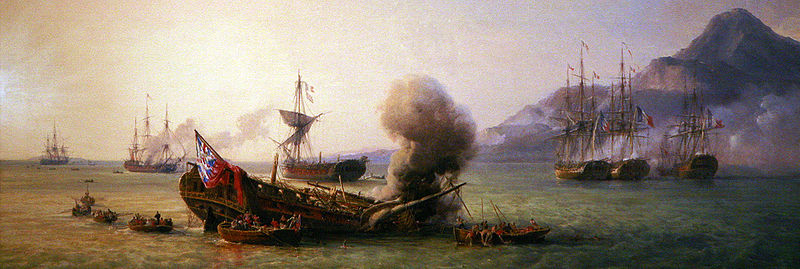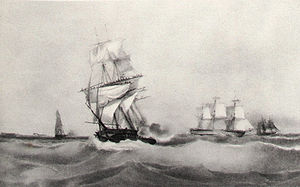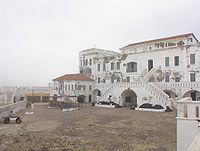
HMS Iphigenia (1805)
Encyclopedia
HMS Iphigenia was a Royal Navy
Royal Navy
The Royal Navy is the naval warfare service branch of the British Armed Forces. Founded in the 16th century, it is the oldest service branch and is known as the Senior Service...
36-gun Perseverance-class fifth-rate
Fifth-rate
In Britain's Royal Navy during the classic age of fighting sail, a fifth rate was the penultimate class of warships in a hierarchal system of six "ratings" based on size and firepower.-Rating:...
frigate. She was built at Chatham Dockyard
Chatham Dockyard
Chatham Dockyard, located on the River Medway and of which two-thirds is in Gillingham and one third in Chatham, Kent, England, came into existence at the time when, following the Reformation, relations with the Catholic countries of Europe had worsened, leading to a requirement for additional...
by Master Shipwright Robert Seppings
Robert Seppings
Sir Robert Seppings FRS was an English naval architect.Seppings was born at Fakenham, Norfolk, and in 1782 was apprenticed in Plymouth dockyard...
.
The French captured her at the debacle of Grand Port
Battle of Grand Port
The Battle of Grand Port was a naval battle between squadrons of frigates from the French Navy and the British Royal Navy. The battle was fought during 20–27 August 1810 over possession of the harbour of Grand Port on Île de France during the Napoleonic Wars...
and in their service she participated in the capture of several British vessels. The British recaptured her and she served in the West Africa squadron
West Africa Squadron
The Royal Navy established the West Africa Squadron at substantial expense in 1808 after Parliament passed the Slave Trade Act of 1807. The squadron's task was to suppress the Atlantic slave trade by patrolling the coast of West Africa...
(or "Preventative Service"), combating the slave trade. She was broken up in 1851 after serving for many years as a training ship.
British service
Captain Henry LambertHenry Lambert
Captain Henry Lambert RN was an officer of the British Royal Navy during the French Revolutionary and Napoleonic Wars. During his career, Lambert served in numerous ships and several military actions with success, participating in the capture of Île Bonaparte in the Indian Ocean as second in...
commissioned Iphigenia and sailed her to the Indian Ocean to join the British squadron off Île de France (now Mauritius
Mauritius
Mauritius , officially the Republic of Mauritius is an island nation off the southeast coast of the African continent in the southwest Indian Ocean, about east of Madagascar...
). The squadron consisted of Iphigenia, Leopard, Magicienne
French frigate Magicienne (1778)
The Magicienne was a frigate of the French Navy, lead ship of her class. The British captured her in 1781 and she served with the Royal Navy until her crew burned her in 1810 to prevent her capture after she grounded at Île de France...
and Néréide
French frigate Néréide (1779)
The Néréide was a Sybille class 32-gun, copper-hulled, frigate of the French Navy. On 22 December 1797 HMS Phoebe captured her and she was taken into British service as HMS Nereide. The French recaptured her at the Battle of Grand Port, only to lose her again when the British took Île de France in...
. The squadron blockaded Île de France from May, and started operations to attempt a take-over on 7 July. Iphigenia was present at the capture of Réunion the next day.

Samuel Pym
Sir Samuel Pym KCB was a British admiral, brother of Sir William Pym.In June 1788, Pym joined the Royal Navy as captain's servant of the frigate Eurydice...
, landed parties to capture the Île de la Passe
Île de la Passe
Ile de la Passe is a rocky islet in the bay off Grand Port on the island of Mauritius. Between 20–25 August 1810, during the British campaign to capture the island from the French, it was the scene of the Battle of Grand Port...
and take control of Port-Impérial
Grand Port
Grand Port is a district encompassing much of the south-eastern part of the island of Mauritius. Its capital is Rose-Belle but the most important town of the district is Mahebourg...
, initiating the Battle of Grand Port
Battle of Grand Port
The Battle of Grand Port was a naval battle between squadrons of frigates from the French Navy and the British Royal Navy. The battle was fought during 20–27 August 1810 over possession of the harbour of Grand Port on Île de France during the Napoleonic Wars...
. From 23 August, the British squadron faced off against a French squadron under Guy-Victor Duperré
Guy-Victor Duperré
Guy-Victor Duperré was a French admiral, Peer of France and thrice Naval Minister....
, comprising Minerve
French frigate Minerve (1809)
The Minerva was a 48-gun frigate of the Portuguese navy.She was captured on 22 November 1809 by Duperré's Bellone, who gave her command to Pierre Bouvet. She subsequently served in the French Navy as Minerve. The two ships sailed together, capturing the East Indiamen Windham and Ceylan in the...
, Bellone
French frigate Bellone (1807)
The Bellone was an 44-gun frigate of the French Navy.She departed Saint-Malo on 18 January 1809, bound for the Indian Ocean, under Guy-Victor Duperré....
and Victor
French corvette Revenant
Revenant was a 20-gun privateer corvette designed by Robert Surcouf for commerce raiding. She was later requisitioned for service in the French Navy, and was renamed Iéna, but was subsequently captured by and served in the Royal Navy as HMS Victor...
. The French had moved the buoys marking the passage through the reef, causing Magicienne and Sirius to run aground and leading the British to scuttle them by fire. Néréide was captured. Iphigenia, which had been kept in reserve, attempted to flee, but French reinforcements under Hamelin - (Vénus
French frigate Vénus (1808)
The Vénus was a Junon class frigate of the French Navy.On 10 November 1808, she departed Cherbourg, bound for Île de France, where she served as Hamelin's flagship, leading a squadron also comprising the frigate Manche and the sloop Créole....
, Manche
French frigate Manche (1803)
The Manche was a 40-gun Hortense Class frigate of the French Navy.She took part in operations at Île de France under Captain François-Désiré Breton....
and Créole
French brig Créole (1809)
The Créole was a three-masted schooner sloop of war of the French Navy.On 26 April 1809, she left île de France under captain Bouvet, part of Hamelin's squadron. She sailed to Manilla, where she captured a British and a Portuguese prize...
) - intercepted her, forcing Iphigenia to strike her colours.
French service
Iphigenia was taken into French service as Iphigénie, under Pierre BouvetPierre François Étienne Bouvet de Maisonneuve
Pierre François Étienne Bouvet de Maisonneuve was a French admiral.Born in Saint-Benoît, Réunion, to a family of sailors, Bouvet started sailing at the age of 12 on the Nécessaire. He was midshipman at 17 on the frigate Aréthuse...
, who had assumed command of the French squadron at Grand Port after Duperré was wounded, and had been promoted to capitaine de frégate. She formed a squadron with Astrée
HMS Pomone (1811)
The Astrée was a 44-gun Pallas-class frigate of the French Navy, launched at Cherbourg in 1809. In December of the next year she captured HMS Africaine. The Royal Navy captured Astrée in 1810 and took her into service under her French name, but then in 1811 recommissioned her as HMS Pomone...
and Entreprenant.

All Africaine's officers had been killed or wounded in the action, save for Colonel Barry, and only 69 men were uninjured. Bouvet was given Corbett's dagger, which he kept thereafter. The French abandoned Africaine and Boadicea recaptured her the next day.
On 3 December 1810, the Île de France fell to the British. The British took over the ships moored at the island, including Iphigénie, Bellone and Astrée. They recommissioned Iphigénie, returning her to service as Iphigenia. Captain Thomas Caulfield then sailed her home to Britain where she was paid off in April 1811.
Return to British service
After fitting out at Portsmouth from November to February 1812, Iphigenia was recommissioned in January under Captain Lucius Curtis. On 25 March 1812 she sailed with a convoy for the East Indies.Later, under Captain Fleetwood Pellew
Fleetwood Pellew
Admiral Sir Fleetwood Broughton Reynolds Pellew CB KCH was an officer of the Royal Navy who served during the French Revolutionary and Napoleonic Wars. He was the son of Captain Edward Pellew, who later became an admiral and first Viscount Exmouth...
, Iphegenia sailed for the Mediterranean on 6 December. In February 1813, while still in the Mediterranean, she came under the command of Captain Andrew King. On 17 April 1814, a British squadron consisting of Furieuse
HMS Furieuse (1809)
Furieuse was a 38-gun frigate of the French Navy. She was captured by the Royal Navy in 1809 and taken into servive as the fifth rate HMS Furieuse.-French career and capture:...
, , Iphigenia, and supported the successful assault on Genoa
Genoa
Genoa |Ligurian]] Zena ; Latin and, archaically, English Genua) is a city and an important seaport in northern Italy, the capital of the Province of Genoa and of the region of Liguria....
. Afterwards, King escorted a convoy of transports from Gibraltar to Bermuda.
Post war
She underwent repairs at Chatham between June and September 1815, and sailed for the East Indies again in October. King returned home from the East Indies in command of the Third Rate CornwallisHMS Cornwallis (1813)
HMS Cornwallis was a 74-gun third rate ship of the line of the Royal Navy, launched on 12 May 1813 at Bombay. She was built of teak. The capture of Java by USS Constitution delayed the completion of Cornwallis as Java had been bringing her copper sheathing from England.On 27 April 1815, Cornwallis...
.
In September 1816 Captain John Tancock took command of Iphigenia in Trincomalee
Trincomalee
Trincomalee is a port city in Eastern Province, Sri Lanka and lies on the east coast of the island, about 113 miles south of Jaffna. It has a population of approximately 100,000 . The city is built on a peninsula, which divides the inner and outer harbours. Overlooking the Kottiyar Bay,...
. In December 1817 he sailed her back to Britain in company with Melville
HMS Melville (1817)
HMS Melville was a 74-gun third rate ship of the line of the Royal Navy, launched on 17 February 1817 at Bombay Dockyard.From 19 January 1836 until August 1837 she served in North America and the West Indies as the flagship of Vice-Admiral Peter Halkett and was commanded by Captain Peter John Douglas...
, whose fitting out in Bombay he had overseen.
Between January and June 1818 she was at Portsmouth having defects made good. Captain Hyde Parker took command on 15 March and eventually sailed Iphigenia for Jamaica. She served also on the Quebec and Mediterranean stations before being paid off on 12 June 1821.

Robert Mends
Captain Sir Robert Mends was a prominent British Royal Navy officer of the late eighteenth and early nineteenth century, who lost an arm in the American War of Independence, caught in an explosion at the Battle of Groix in 1795 and wounded again at the Action of 6 April 1809...
. She then served in the anti-slave patrol off Africa with Mends as Commodore of the West Africa squadron. On 22 March 1822 she transported Sir Charles McCarthy, Governor of Sierra Leone, to Cape Coast Castle
Cape Coast Castle
Cape Coast Castle is a fortification in Ghana built by Swedish traders. The first timber construction on the site was erected in 1653 for the Swedish Africa Company and named Carolusborg after King Charles X of Sweden. It was later rebuilt in stone....
to assume the governorship of the Gold Coast
Gold Coast (British colony)
The Gold Coast was a British colony on the Gulf of Guinea in west Africa that became the independent nation of Ghana in 1957.-Overview:The first Europeans to arrive at the coast were the Portuguese in 1471. They encountered a variety of African kingdoms, some of which controlled substantial...
.
On 15 April, her boats captured six slave ships on the Bonny River
Bonny River
Bonny River is a river in Rivers State, Nigeria. Water taxis which move along the river provide the connection between Bonny Island and Port Harcourt, the capital of Rivers State, which lies alongside the river.-External links:*...
: Vigilante, Petite Betsey, Ursule, the Spanish Yeanam, Becaa and the French brigantine Utile. In June Yeanam foundered in a tornado, claiming the lives of two officers, 16 men and 400 slaves; seven of the Iphigenias crew managed to survive on the wreckage of the Yeanam.

